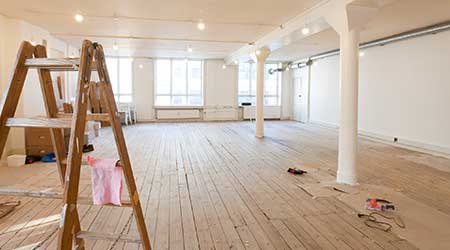Successful Painting Projects Require Plenty of Front-End Planning
First of a two-part article explaining the steps to take to ensure painting projects get off on the right foot.
In an era of tight facility budgets and lean facility staffs, facility managers look for every opportunity to save time and money. Painting may seem like a routine task, but if facility managers wish to maximize their painting dollars over the long term, they will need to carefully plan and execute each project.
The bottom line is simple: “You get what you pay for,” says Cris Crissinger, a consultant who was formerly director, corporate specifications, McMillan Pazdan Smith Architecture. It may be more economical in the short term to use cheaper materials, but such a system will cost more money to maintain over a period of years, he says. The same principle applies to surface preparation and application. A paint job can last a couple of years or even 20 years or more, depending on how well the painting was done and how good the materials used.
That’s not to say that every project should be budgeted so that it can last for 20 years. “In some cases it is more cost effective to spend money up front, but if people are changing their brand every six to ten years, then why spend a lot of money?” asks Ken Trimber, president of KTA-Tator, a third-party inspection company for infrastructure, and a member of four ASTM committees that deal with coatings, building performance, and durability. “If you are going to tear a building down in a few years, for example, all you may want is a Band-Aid.”
Finding the right paint
The choice of paint or coating will depend on a number of factors. Indoors, aesthetics become important, says Terry Carroll, commercial services business unit manager for KTA-Tator, and the sheen chosen will vary by substrate. In hospital buildings, antimicrobial coatings will be put down to resist contamination, especially in laboratory settings.
Dry-fall paint is used to coat exposed, metal-deck ceilings, which is literally dry when it hits the floor. In choosing colors, it is important to consider how much fade is allowable. That’s because fade varies according to hue. Earth tones will wear better than bright colors, for example.
The first place to get information about paint is from the product data sheet, which lists paint characteristics, including VOC (volatile organic compound) level, how many square feet will be covered by a gallon of paint, how fast the paint will dry, and how soon the applier can recoat.
The Master Painters Institute maintains the gold standard for judging paints, as determined by both the Canadian and American governments, and is a good source to consult before starting a painting project. “We have established 200 categories of paint designed for a specific purpose, and we test products against those performance standards,” says Barry Law, president of Master Painters Institute. “If you walk into a big box store and ask the paint expert which is the best paint, they may recommend the thickest, but this has no bearing on the duty cycle. We look at how long the paint will last.”
Get a good start
As important as paint is to a painting project, it is the least costly item. The most expensive part of a painting project is the cost of labor, which includes scaffolding, tearing down, prepping, and transportation, says Crissinger.
Proper preparation of the surface before painting is critical and can include washing, scraping, abrasive blast cleaning, or chemical stripping, and the paint job may need to be sealed, depending on the application, says Trimber.
“First, the degree of surface degradation (DSD) has to be assessed, since the level of damage to the previous paint job will dictate how the surface is prepped. Then the surface prep requirements are assessed (Master Painters identifies 28 different surfaces or substrates), and finally, the paint system, grade, and products are chosen,” says Law.
A good paint specification should address surface preparation at least as much as it does application or the paint itself. “Every specification used with a coating does reference SSPC (Society for Protective Coatings) standards for different types of surface preparation,” Carroll explains.
Given the importance of surface preparation, it should be carefully specified in any contract. “If the contractor says ‘surface preparation as required,’ that is subjective, and the property manager cannot allow that,” says Law.
A good contractor has at least one NACE (National Association of Corrosion Engineers) certified painter who has gone through quality control and inspection training, says Crissinger, and knows about different techniques needed for different types of jobs. A paint failure can occur because of improper prepping, so expertise is necessary to head off such problems. Walls have to be cleaned, and plaster, gypsum, and plywood, for example, call for different surface preparation techniques. “A good painter will check for moisture in the walls, for example,” Crissinger says. “They will then dry them out or replace them, after they find out why the wall is wet.”
Related Topics:













